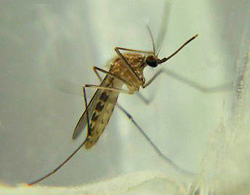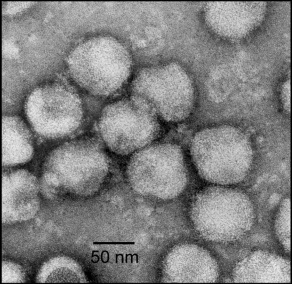
Rift Valley fever (RVF) is a viral disease of humans and livestock that can cause mild to severe symptoms. The mild symptoms may include: fever, muscle pains, and headaches which often last for up to a week. The severe symptoms may include: loss of sight beginning three weeks after the infection, infections of the brain causing severe headaches and confusion, and bleeding together with liver problems which may occur within the first few days. Those who have bleeding have a chance of death as high as 50%.

The Appendix Vergiliana is a collection of poems traditionally ascribed as being the juvenilia of Virgil.

Culex is a genus of mosquitoes, several species of which serve as vectors of one or more important diseases of birds, humans, and other animals. The diseases they vector include arbovirus infections such as West Nile virus, Japanese encephalitis, or St. Louis encephalitis, but also filariasis and avian malaria. They occur worldwide except for the extreme northern parts of the temperate zone, and are the most common form of mosquito encountered in some major U.S. cities, such as Los Angeles.

The discipline of medical entomology, or public health entomology, and also veterinary entomology is focused upon insects and arthropods that impact human health. Veterinary entomology is included in this category, because many animal diseases can "jump species" and become a human health threat, for example, bovine encephalitis. Medical entomology also includes scientific research on the behavior, ecology, and epidemiology of arthropod disease vectors, and involves a tremendous outreach to the public, including local and state officials and other stake holders in the interest of public safety.
Diptilon is a genus of moths in the subfamily Arctiinae. The genus was erected by Otto von Prittwitz in 1870.

Culex pipiens, commonly referred to as the common house mosquito, is a species of mosquito. House mosquitoes are some of the most common mosquitoes in the United States. More specifically, Culex pipiens is considered as the northern house mosquito, as it is the most common mosquito to the northern regions of the US. North of the 39th parallel north in the US, only C. pipiens are present, whereas south of the 36th parallel north, only C. quinquefasciatus are present. Additionally, they can be found in both urban and suburban temperate and tropical regions across the world.

Culex quinquefasciatus, commonly known as the southern house mosquito, is a medium-sized mosquito found in tropical and subtropical regions of the world. It is a vector of Wuchereria bancrofti, avian malaria, and arboviruses including St. Louis encephalitis virus, Western equine encephalitis virus, Zika virus and West Nile virus. It is taxonomically regarded as a member of the Culex pipiens species complex. Its genome was sequenced in 2010, and was shown to have 18,883 protein-coding genes.

Usutu virus (USUV) is a flavivirus belonging to the Japanese encephalitis complex, which is an emerging zoonotic arbovirus of concern because of its pathogenicity to humans and its similarity in ecology with other emerging arboviruses such as West Nile virus. It mainly infects Culex mosquitoes and birds; humans form a dead-end host. First identified in South Africa in 1959, the virus has caused outbreaks in birds across Europe since 1996. Nearly 50 cases in humans have been reported as of 2019, mainly in Europe. These are predominantly asymptomatic, but some people experience neurological symptoms.

Mesoniviridae is a family of enveloped, positive-strand RNA viruses in the order Nidovirales which infect mosquitoes. The family is named after the size of the genomes relative to other nidoviruses, with meso- coming from the Greek word mesos, which means medium, and -ni being an abbreviation of nido.
Diptilon aterea is a moth of the subfamily Arctiinae. It was described by William Schaus in 1901. It is found in Brazil and Paraguay.
Diptilon aurantiipes is a moth of the subfamily Arctiinae. It was described by Rothschild in 1911. It is found in Brazil.
Diptilon crassa is a moth of the subfamily Arctiinae. It was described by Hans Zerny in 1912. It is found in Colombia.
Diptilon flavipalpis is a moth of the subfamily Arctiinae. It was described by George Hampson in 1911. It is found in Argentina.
Diptilon gladia is a moth of the subfamily Arctiinae. It was described by E. Dukinfield Jones in 1914. It is found in Brazil.
Diptilon hoffmannsi is a moth of the subfamily Arctiinae. It was described by Rothschild in 1911. It is found in Peru.
Diptilon proleuca is a moth of the subfamily Arctiinae. It was described by Druce in 1905. It is found in Venezuela.
Diptilon sylpha is a moth of the subfamily Arctiinae. It was described by Paul Dognin in 1902. It is found in Ecuador.
The Euchromiina are a subtribe of tiger moths in the family Erebidae. It was described by Arthur Gardiner Butler in 1876. Many species in the subtribe are mimics of wasps.
Pylore Krishnaier Rajagopalan is an Indian vector control scientist, biologist and acarologist, known for his pioneering contributions to the control programmes against vector-borne diseases in India.[1] He is a former director of the Indian Council of Medical Research managed Vector Control Research Centre, Pondicherry.[2][3] He graduated in 1949 from the Banaras Hindu University and obtained a Masters in Zoology with University First Rank there itself in 1951. In 1952 he joined the fledgling Virus Research Centre in Pune, and worked under the supervision of some of the finest vector control specialists such as Dr T Ramachandra Rao. In recognition of his outstanding work as a young research scientist, in 1957 he was awarded a Fellowship by the Rockefeller Foundation to pursue a Master's program in Public Health from the University of California.[4] He went on to secure a Diploma in Acarology from the University of Maryland at College Park.
Culex perfuscus is the only Culex species mosquito currently implicated as a possible vector of Zika virus. The species type was described in 1914 from Port Herald, Nyasaland by entomologist Frederick Wallace Edwards.







